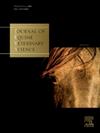Association of seminal plasma and alternative cryoprotectants with the antioxidant and the fertilizing capacity of cryopreserved sperm in donkeys
IF 1.3
3区 农林科学
Q2 VETERINARY SCIENCES
引用次数: 0
Abstract
Seminal plasma (SP) in Equidae is involved in several events that precede sperm fertilization, such as motility activation, antimicrobial action, metabolite neutralization, and a mediating effect on sperm capacitation and postcoital uterine inflammatory response. In the donkey species, it has been shown that SP can provide to sperm subjected to cryopreservation, a greater antioxidant capacity, since SP contains various molecules that can protect spermatozoa from oxidative stress. The aim of this study was to evaluate the association between seminal plasma components (proteins and enzymes) and alternative cryoprotectants, with the antioxidant and the fertilizing capacity of cryopreserved sperm of Colombian Creole donkeys. Ten Colombian Creole donkeys (Equus asinus) were collected using the artificial vagina method to obtain three ejaculates per animal, for a total of 30 ejaculates. A fraction of each ejaculate was centrifuged to obtain the SP. Evaluation of some components of seminal plasma was performed. The enzymes catalase, superoxide dismutase and glutathione peroxidase were evaluated by spectrophotometry and the concentration of the cysteine-rich secretory 2 (CRISP-2) protein 2 by the ELISA assay. For semen cryopreservation, treatments with different combinations of dimethylformamide (DMF), sucrose (SAC) and homologous seminal plasma (SP) were used. In thawed semen, total antioxidant capacity was evaluated by the ABTS and ORAC assays; additionally, the reactive oxygen species (ROS) production was evaluated. Fertilizing capacity was evaluated using a sperm binding assay to the zona pellucida of oocytes. The semen quality index (SQi) was calculated for total motility, progressive motility, vitality and plasma membrane integrity. Correlation and regression analysis were performed between the SP components, TAC, ROS and fertilizing capacity. For the comparisons of means, a Tukey Test was carried out. For CRISP-2 a positive correlation coefficient of 0.17 with the seminal quality index (SQi) of thawed semen, was obtained (P< 0.05). The sperm binding to the zona pellucida was 265.34±11.03, 135.2±7.66, 268.37±9.01 and 299.14±10.22 for treatments of 5% DMF; 0.2M SAC and 1% BSA; 5%DMF, 0.2M SAC and 10% SP; and 5% DMF, 0.2M SAC and 10% SP, respectively. The last treatment being the one with a higher value (P< 0.05). For the combination 5% DMF and 10% SP; 0.2 SAC,1%BSA and 10% SP, it could be found that the antioxidant capacity measured by the (ABTS) method had a negative regression coefficient with total ROS (P<0.05). In conclusion, SP components, TAC and ROS are associated with semen quality and the fertilizing capacity of donkey sperm. Additionally, freezing of semen under a medium composed of dimethylformamide (DMF), bovine serum albumin (BSA) and seminal plasma (PS), improves the adherence of sperm to the zona pellucida, being a favorable indicator of the fertilizing capacity of donkey sperm.
驴精浆和其他冷冻保护剂与低温保存精子抗氧化和受精能力的关系
马科动物的精浆(SP)参与了精子受精前的几个事件,如运动激活、抗菌作用、代谢物中和以及对精子获能和性交后子宫炎症反应的介导作用。在驴种中,已经证明SP可以为冷冻保存的精子提供更大的抗氧化能力,因为SP含有各种可以保护精子免受氧化应激的分子。本研究的目的是评价哥伦比亚克里奥尔驴精浆成分(蛋白质和酶)和替代冷冻保护剂与冷冻保存精子的抗氧化和受精能力之间的关系。采用人工阴道法采集10头哥伦比亚克里奥尔驴(Equus asinus),每头驴射精3次,共射精30次。每次射精的一部分被离心以获得SP。对精浆的一些成分进行评估。分光光度法测定过氧化氢酶、超氧化物歧化酶和谷胱甘肽过氧化物酶,ELISA法测定富含半胱氨酸分泌2 (CRISP-2)蛋白2的浓度。精液冷冻保存采用二甲基甲酰胺(DMF)、蔗糖(SAC)和同源精浆(SP)的不同组合处理。在解冻后的精液中,用ABTS和ORAC测定总抗氧化能力;此外,还评估了活性氧(ROS)的产生。利用精子与卵母细胞透明带的结合试验来评估受精能力。计算精液质量指数(SQi),包括总活力、渐进活力、活力和质膜完整性。对SP组分、TAC、ROS与施肥力进行相关和回归分析。对于平均值的比较,采用Tukey检验。CRISP-2与解冻后精液质量指数(SQi)的正相关系数为0.17 (P<;0.05)。5% DMF处理精子与透明带的结合分别为265.34±11.03、135.2±7.66、268.37±9.01和299.14±10.22;0.2M SAC和1% BSA;5%DMF, 0.2M SAC, 10% SP;5% DMF、0.2M SAC和10% SP。最后一个处理是具有较高值的处理(P<;0.05)。5% DMF和10% SP的组合;0.2 SAC、1%BSA和10% SP时,可以发现(ABTS)法测定的抗氧化能力与总ROS呈负回归系数(P<0.05)。综上所述,SP组分、TAC和ROS与驴精子的精液质量和受精能力有关。此外,在二甲甲酰胺(DMF)、牛血清白蛋白(BSA)和精浆(PS)组成的培养基中冷冻精液,可以提高精子对透明带的粘附性,这是驴精子受精能力的一个有利指标。
本文章由计算机程序翻译,如有差异,请以英文原文为准。
求助全文
约1分钟内获得全文
求助全文
来源期刊

Journal of Equine Veterinary Science
农林科学-兽医学
CiteScore
2.70
自引率
7.70%
发文量
249
审稿时长
77 days
期刊介绍:
Journal of Equine Veterinary Science (JEVS) is an international publication designed for the practicing equine veterinarian, equine researcher, and other equine health care specialist. Published monthly, each issue of JEVS includes original research, reviews, case reports, short communications, and clinical techniques from leaders in the equine veterinary field, covering such topics as laminitis, reproduction, infectious disease, parasitology, behavior, podology, internal medicine, surgery and nutrition.
 求助内容:
求助内容: 应助结果提醒方式:
应助结果提醒方式:


